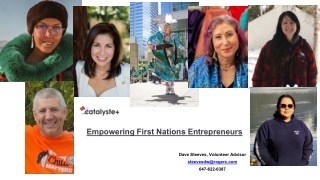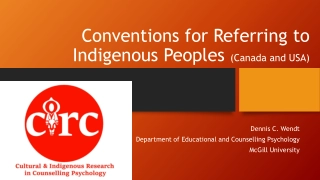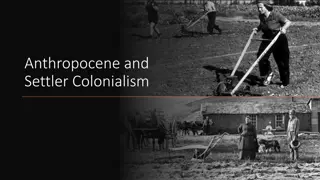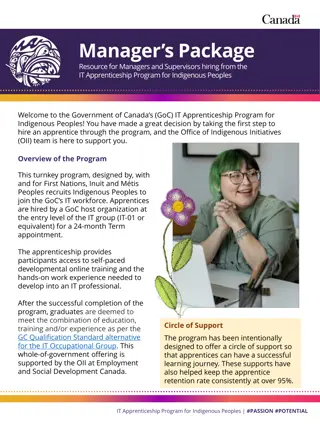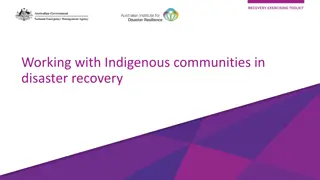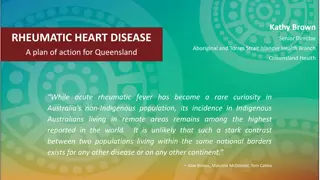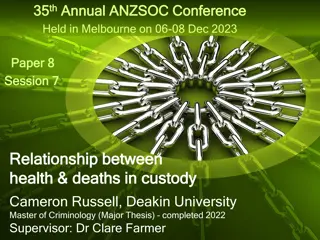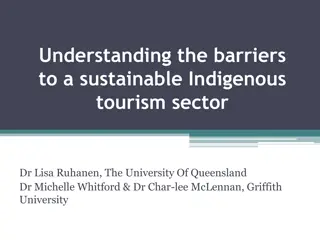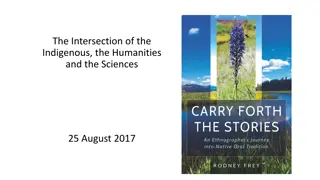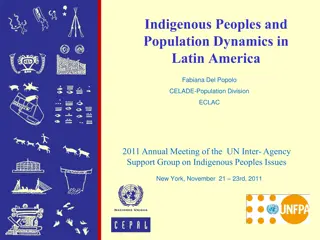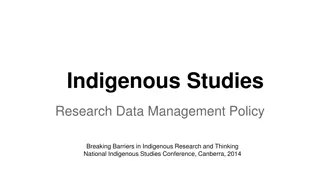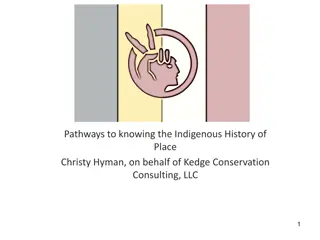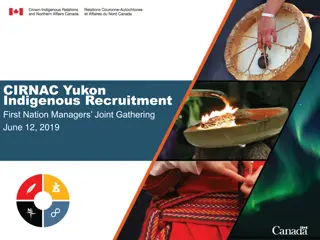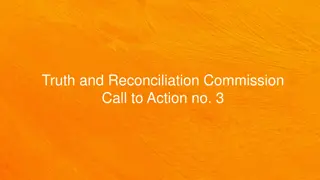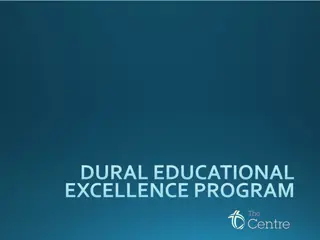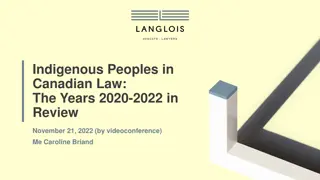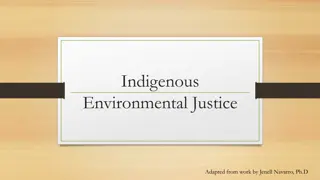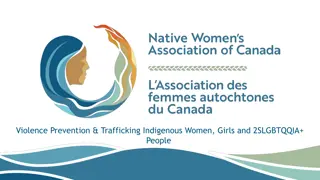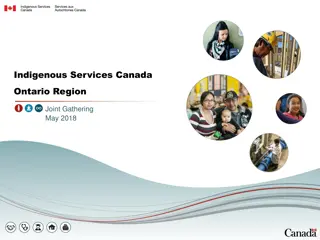Supporting Indigenous Communities During COVID-19: Challenges and Solutions
Indigenous communities face unique vulnerabilities during the COVID-19 pandemic, with elders being particularly at risk due to higher rates of chronic illnesses and living conditions. The lack of access to essential resources like clean water, food security, mental health support, and technology further exacerbates the challenges. Historical traumas compound the current crisis, making it essential to provide tailored support to protect cultures, languages, and traditions.
Download Presentation

Please find below an Image/Link to download the presentation.
The content on the website is provided AS IS for your information and personal use only. It may not be sold, licensed, or shared on other websites without obtaining consent from the author. Download presentation by click this link. If you encounter any issues during the download, it is possible that the publisher has removed the file from their server.
E N D
Presentation Transcript
Supporting Indigenous Children Youth and Families Supportive options during the COVID-19 Pandemic and Social Distancing Restrictions April 20, 2020 Webinar presented by C Doolittle and B Maracle, ANCFSAO
Section One Protecting our Communities, our Cultures, our Children, our Elders, our Families
Vulnerability of Indigenous Communities COVID-19 is the deadliest threat to our Elders, the Knowledge Keepers of our Nations.
Vulnerability of Indigenous Communities Indigenous people and communities are particularly vulnerable to the spread of COVID-19. Higher rates of chronic illnesses. Higher susceptibility to contract illnesses due to: Lack of housing; Cramped living situations; Reliance on each other for sustainability, supports; Water crisis.
Vulnerability of Indigenous Communities (cont d) Vulnerable Elders and risks of fatality Holders of our Cultures, Language, Ceremonies and Traditions. Mental Health: Higher rates of suicide, self-harm Isolation and traumatic events escalate worries. Lack of access to children adding additional worries. Communication and understanding challenges.
Vulnerability of Indigenous Communities (cont d) History of traumatic events and re-triggering trauma Famine Smallpox Bio-warfare Indian agent control of who comes/leaves Child removal/limiting access
Vulnerability of Indigenous Communities (cont d) Lack of access to tools recommended to combat Access to clean water (boil advisories, do not use/do not consume) Access to food security: groceries, storage capacity, cost, delivery Access to mental health support Access to PPE, medical support Evacuation planning (flooding) Access to technology, internet, cells/service
Section Two Our Children Placed Away From Home
Concerns from families Our children deserve to have a sense of belonging and deserve to feel secure in their identities.
Concerns from families Suspended all face to face access Under what circumstances has this occurred? What has been offered as the alternative? How long will this last? What is needed to resume access? Have you explained this in a way that will help families understand?
Concerns from families Community lock-downs: once you leave, you can t return Impacts on the whole family unit. Have you contacted the community to understand the protocol for entering/leaving the territory?
Concerns from families Limited to residents and essential workers/employees Ombudsman reports 50% of the communities are on lockdown/limited community access. Encouraged and supported by both provincial and federal governments.
Residential Services Indigenous Agencies were already concerned with Residential Services and the selection of specialized resource homes and facilities pre- pandemic. Lack of available homes to support higher needs. Lack of spacing, infrastructure, buildings to support temporary shelters, isolation units, medical facilities, house support people, unreliable technology, transportation.
Residential Services (contd) OPR searches as a result of requested moves, being informed of no placements being accepted, having to seek alternatives for highly vulnerable youth. Risks: suicide, illness/death, increased chance of mental health breakdowns. Higher costs to set up temporary hotel accommodations and staff. Upfront costs associated with setting up isolation areas.
Section Three What concerns us about child welfare and support agencies?
Band Representatives Lack of PPE Attending the homes without having any PPE risks furthering the spread of COVID-19. Supporting our agencies by doing visits, contacting families, checking in, requires PPE. Workers are not receiving hazard pay. Providing additional supports to caregivers, families, children/youth. Limited budgets, reliant on promised funds. Already inequitable.
Financial Instability Financial Instability Causing further stress/pressure on agencies. Funding sources have slow response levels. Funding already inequitable. Hazard pay not feasible for all agencies. Providing additional financial support to caregivers, families, children/youth causing strain.
Front-line capacity Human resources capacity Already under-resourced. Current resources are depleting quickly. Staff with pre-existing health issues are at risk. Health and safety. Altered on-call systems for staff in place to accommodate those with families.
Front-line capacity (contd) Urban non-child welfare agencies. Limited communication of supports offered by child welfare agencies. Limited budgets to support additional client needs, out of scope, unaware of supports potentially available.
Section Four What is working and how can you help?
A sense of belonging Isolation impacts on mental health Have you connected with every child, youth, family member? Do all families and parents have access to technology? Have you explained in a way they can comprehend (limitations) social distancing is occurring? Have you set up social support platforms?
A sense of belonging (contd) Lack of access to disrupted families Are all families, parents, siblings getting access? What challenges exist? How can you remedy this? What has been offered? Some access is occurring in the homes Closed communities, extended family care, extended access visits with supports, PPE provided to children, families, and FP.
Communication Communication and Collaboration Some communities more prepared for this due to ongoing needs for community reliance. Band representatives are very collaborative and checking in on the families, supporting in locating families, bringing them into Skype meetings. Community based teams/devolved models are working well for community supports.
Communication Increased case conferencing for complex cases and needs. Caregiver supports: increased one-on-one supports and respites. Collaborating with local produce farmers for access to fresh vegetables, egg, and milk products. Increased team, management, senior leadership, and all agency staff meetings in an effort to remain connected.
Family and Community Supports Family and community supports during pandemic Funding land-based camps for evacuees. Prepare and deliver: Activity boxes for children and families; Cultural bundles, medicines, instruction on preparation; Food hampers, fresh produce, dairy, non-perishable items; Lunch programs; PPE kits to caregivers including wipes, sanitizers, cleaners, gloves, masks, gowns, booties.
Family and Community Supports (cont d) Identify client needs and base supports accordingly: Grocery shopping; Providing medicines with accompanying preparation videos; Gift cards; Access to technology, rent assistance, transportation needs. Virtual counselling sessions for mental health supports. Virtual parenting group platforms. Virtual support groups for caregivers, men, and women.
Family and Community Supports Coordinate for contacts using porch drop-offs to high risk families and for families in need, while proactively responding. Children Youth Families Age appropriate toys & activities Land-based play Smudge kits Food baskets Sibling kits Healthcare baskets Snacks Gift cards for online purchases Movie night baskets Arts and crafts Pamper Me baskets Game night baskets Play equipment & outside items Sanitizer, anti-germ baskets Bonfire night baskets Moccasin making and beading kits Gardening starter kits Bird feeder kits
Family and Community Supports Jordan s Principle Please continue applications for First Nations Children and Youth that need assistance for health and educational needs during the COVID-19 pandemic. Ask the First Nations Chiefs What kinds of supports and assistance do families need to ensure safety of the children and youth? How can your agency meet these needs? Duty to Respond and targeting healthy functioning community leaders.
Family and Community Supports Culture Videos made by Elders or knowledge keepers that can be shared with families and youth in rural and urban locations (eg. traditional teachings & preparations, social distancing, surviving COVID- 19, role in keeping our children/youth safe). Questions and Answer sessions with Elders or Knowledge Keepers can be coordinated Collaborate and communicate with urban Indigenous organizations Offer additional resources to the agencies: laptops, tablets, supplies
All Lives Matter When this is all over, we will hold each other close. But right now, we need to show unimaginable strength and do everything in our power to ensure we do not lose any more lives. Mark Hill, Elected Chief of Six Nations of the Grand River


